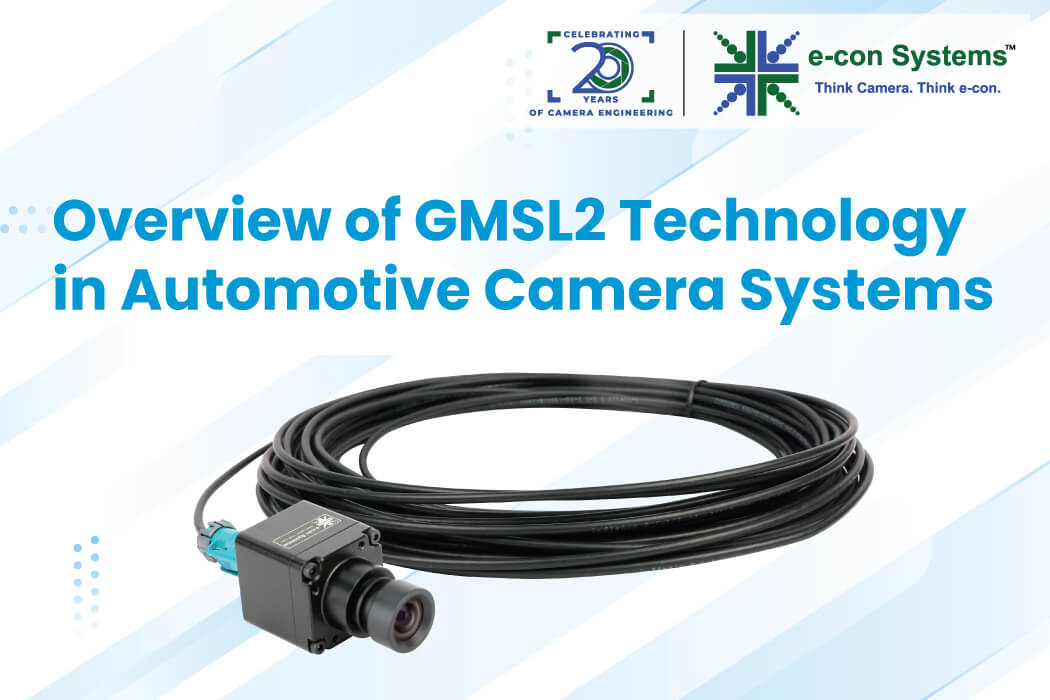GMSL2 (Gigabit Multimedia Serial Link 2) is the second generation of GMSL, a popular interface used in embedded vision for high-bandwidth long-distance transmission. GMSL was introduced in 2017 by Maxim Integrated™ with 3K video and gigabit ethernet support, which was followed by the release of GMSL2 in 2018 with 4K video support.
GMSL2 comprises sets of serializer and deserializers (SerDes) ICs. It can provide multi-stream support with a single cable. This interface addresses the needs of high bandwidth, complex interconnect, data integrity, and low power requirements.
GMSL2 is known for its advantages of high-speed data transmission, high-resolution imagery, uncompressed video transmission, multiple interface support, and a bidirectional communication path.
Keep reading as we explore the scope of GMSL2 and its functionalities in this blog.
GMSL2 Performance
These GMSL2 cameras can be placed 15 meters away from the host processor through the 50Ω coaxial cable or 100Ω STP or SPP to operate at full speed, and still support a high frame rate and less latency. Using the SerDes technique, this cable can carry high-speed video of up to 6Gbps per lane.
What is a SerDes Technique?
SerDes is a functional block that serializes and deserializes digital data used in high-speed chip-to-chip communication. A SerDes is capable of parallel-to-serial and serial-to-parallel data conversion, impedance-matching circuitry, and clock data recovery functionality.
The primary role of SerDes is to minimize the number of I/O interconnects. The serializer component, which converts parallel data to serial data, is used on the transmitter side. Meanwhile, the deserializer will be on the receiver side, which does serial to parallel data conversion.
Converting the data using SerDes reduces the number of data paths needed to transmit data and the number of required connecting pins or wires. It additionally addresses other issues that come with transmitting parallel data, such as greater power consumption and susceptibility to electromagnetic interference.
GMSL2 Features and Their Advantages
Distance of Transmission: The transmission distance of GMSL2 depends on the specific implementation, the quality of cables used, and the transmission speed. GMSL2 can support high data rates (up to several Gbps) over relatively long distances. Typically, it can transmit data over tens of meters (ranging from 10 to 15 meters) with proper cable quality and signal integrity.
However, it’s important to note that the actual transmission distance can vary based on factors such as cable quality, signal degradation, interference, and the specific components used in the system. Manufacturers often provide guidelines regarding the maximum supported distances for their implementations of GMSL2 technology.
Bandwidth: The bandwidth of GMSL2 can vary based on its configuration and implementation. Generally, GMSL2 can support high data rates, often ranging from 1 Gbps (Gigabit per second) to several Gbps, depending on factors such as the specific hardware used, the quality of cables, and the settings configured in the system.
EMI/EMC Interference: GMSL2 implementations often incorporate robust shielding in cables and connectors to minimize the effects of external electromagnetic interference. This shielding helps maintain signal integrity and prevents signal degradation due to interference.
To improve the reliability, GMSL2 utilizes spread-spectrum technology. Spread-spectrum capability is built into each SerDes design to improve the electromagnetic interference (EMI) performance of the link without the need for an external spread-spectrum clock. GMSL2 link can be bridged with any video protocol, such as DisplayPort to CSI-2 or HDMI to OLDI. GMSL2 SerDes also seamlessly meets the automotive industry’s strict electromagnetic compatibility (EMC) requirements.
Virtual Channel Support: GMSL2 employs a packet-based communication protocol where each packet contains a header specifying a unique virtual channel identifier. This allows the segregation and management of multiple data streams within a single physical link. This virtual channel identification method enables the multiplexing of diverse data types, such as video, control signals, and sensor data, over the same transmission path.
Through the allocation of bandwidth and priority settings per virtual channel, GMSL2 optimizes data transmission. This is done by segmenting and prioritizing the streams. It ensures efficient utilization of the available bandwidth while allowing for the simultaneous transmission of varied data types without compromising performance or real-time requirements.
Multi-Camera Synchronization: Synchronization mechanisms embedded in GMSL2 facilitate temporal alignment of captured data across cameras, ensuring accurate timestamping for coherent data processing. This protocol’s scalability permits integration with various camera configurations, enabling automotive systems to efficiently manage and transmit multiple high-definition video streams from diverse cameras within the vehicle environment.
Platform Compatibility: Synchronization mechanisms embedded in GMSL2 facilitate temporal alignment of captured data across cameras, ensuring accurate timestamping for coherent data processing. This protocol’s scalability permits integration with various camera configurations, enabling automotive systems to efficiently manage and transmit multiple high-definition video streams from diverse cameras within the vehicle environment.
[ADD Automatic Repeat Request & Video Duplication from the website’s existing blog]
GMSL2 Applications in Automotive Cameras
GMSL2 interface is primarily used in automotive applications due to its high-bandwidth, long-distance, and reliable data transmission capabilities. Let’s delve into its applications and the reasons behind its growing adoption.
- Advanced Driver-Assistance Systems (ADAS): GMSL2 plays a critical role in ADAS features like surround-view cameras, blind-spot monitoring, and lane departure warning systems. Here’s why:
- High-Resolution Video: GMSL2’s ability to transmit uncompressed high-resolution video feeds is essential for ADAS applications where precise visual details are crucial for accurate object detection and recognition.
- Long-Distance Connectivity: Cameras in various locations around a vehicle (front, rear, sides) need to connect to a central processing unit. GMSL2’s ability to transmit data reliably over 10-15 meters eliminates the need for complex cable routing solutions.
- Real-Time Performance: ADAS functions require real-time processing of visual data. GMSL2’s low latency ensures minimal delays in data transmission, enabling prompt response from ADAS systems.
- Reduced Cable Complexity: A single GMSL2 cable transmits power, control signals, and multiple video streams, simplifying cable management within a car’s already congested interior.
- Automatic Emergency Braking (AEB): GMSL2 cameras can be mounted on the front of a vehicle to detect potential collisions with objects or pedestrians ahead. The high-resolution video and real-time performance allow the system to react quickly and initiate braking if necessary.
- Traffic Sign Recognition (TSR): GMSL2 cameras can be used to capture clear images of traffic signs, even from a distance. This information can then be processed by the car’s computer to identify speed limits, stop signs, and other important road signage, assisting drivers and potentially preventing violations.
- Night Vision Systems: GMSL2 cameras can be paired with night vision technology for improved visibility in low-light conditions. The high bandwidth allows for the transmission of detailed night vision images, helping drivers navigate safely during nighttime journeys.
- Driver Monitoring Systems (DMS): GMSL2 cameras can be strategically placed inside the car to monitor driver behavior. These cameras can detect drowsiness, distraction, or other signs of fatigue, potentially triggering alerts or corrective actions to ensure driver safety.
- Automatic Parking Systems: Multiple GMSL2 cameras can be used to create a 360-degree surround view of the vehicle. This allows drivers to see their surroundings clearly during parking process, reducing the risk of collisions with other vehicles or objects.
Remote Monitoring for Fleet Management: GMSL2 cameras can be integrated into commercial vehicles to provide real-time video feeds for fleet managers. This allows them to monitor driver behavior, track vehicle location, and ensure smooth operation of their fleet.
GMSL2 Cameras offered by e-con Systems
e-con Systems, an industry pioneer, has 20+ years of experience in designing, developing, and manufacturing OEM cameras for various industries, including medical and life sciences.
Check out our newly launched GMSL2 cameras, STURDeCAM31 and STURDeCAM31_CUOAGX (for Jetson AGX Orin).
Visit our GMSL2 Camera Page to view all of the GMSL2 cameras we developed.
We have curated various GMSL2 cameras catering to different requirements over the years; see all the GMSL2 cameras curated by us here – GMSL2 Cameras by e-con Systems.
For any camera-related queries or customization services, write to us at camerasolutions@e-consystems.com.

Prabu is the Chief Technology Officer and Head of Camera Products at e-con Systems, and comes with a rich experience of more than 15 years in the embedded vision space. He brings to the table a deep knowledge in USB cameras, embedded vision cameras, vision algorithms and FPGAs. He has built 50+ camera solutions spanning various domains such as medical, industrial, agriculture, retail, biometrics, and more. He also comes with expertise in device driver development and BSP development. Currently, Prabu’s focus is to build smart camera solutions that power new age AI based applications.




